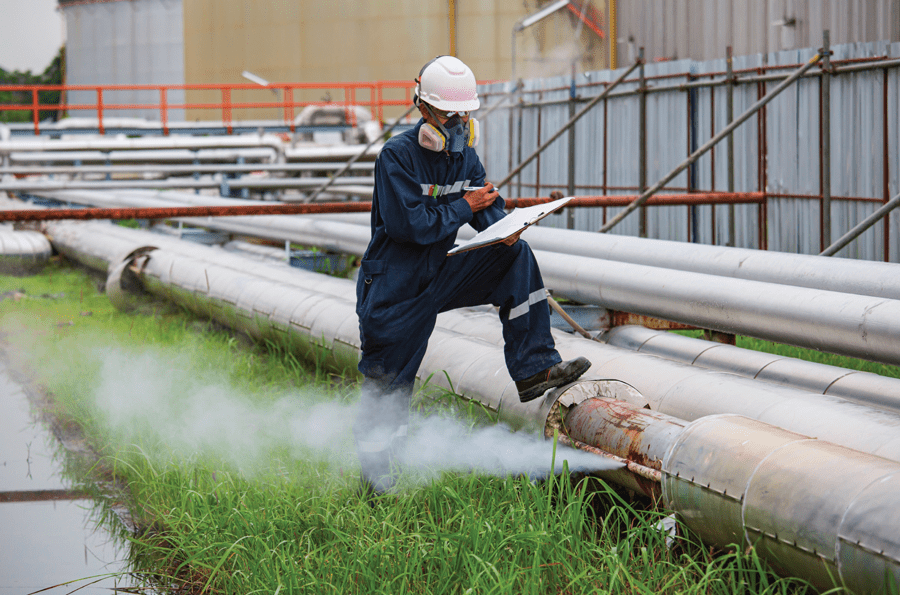According to the International Energy Agency (IEA), more than 40% of the world’s gas reserves are sour, containing significant levels of acidic compounds such as hydrogen sulfide (H2S) and carbon dioxide (CO2). Monetizing these assets requires tremendous collaboration between oil and gas producers, pipeline operators, and technology licensors who can effectively and safely treat these contaminants.
Within this trilogy, pipeline operators play a crucial role in the oil and gas sector by facilitating the transportation of products to treatment facilities, storage depots, and refinery complexes.
As is true for any global economy, the U.S. relies heavily on pipelines for the safe and clean transport of crude, petroleum, and natural gas products for exports as well as within domestic consumption of these products.
According to the U.S. Department of Transportation’s Pipeline and Hazardous Materials Safety Administration (PHMSA), the United States has more than 2.8 million miles of natural gas pipelines, including 2.3 million miles of natural gas distribution and over 300,000 miles of transmission pipelines.
Although safer than road, rail, or barge transportation, pipelines are not without fault. Many of the almost 2.8 million miles of pipelines spanning the nation operate beyond their design service life. Pipeline owners, operators, and engineers continually face the potential of corrosion, welding or equipment failures, excavation damage, freeze-thaw cycles, soil erosion or other external applied forces.
Initially established in the early 1970s, PHMSA’s pipeline safety regulations were based primarily on industry consensus standards in effect at the time. Since then, PHMSA has refocused on regulating pipe replacement, modernization projects, work packages, older pipeline records, safety management systems, and other issues related to high-risk aging pipelines.
In 2020, Congress enacted the Protecting Our Infrastructure of Pipelines and Enhancing Safety (PIPES) Act of 2020, which was designed to strengthen PHMSA’s safety authority and include mandates and provisions to expand its mission related to protecting the environment.
Monitoring and maintenance approaches are costly and inefficient because pipelines are often installed on a large scale and in inaccessible and hazardous environments. Physical inspections have typically involved smart pigs that travel through the pipelines and scan the pipe walls. They were considered the best tool in the industry for the job, yet by PHMSA’s admission, they are not foolproof. Given the age and condition of the pipeline system across the United States, any untreated or semi-treated hydrocarbons being transported provide a significant risk for leakages of impurities.
Since pipelines transport valuable and hazardous substances, any potential failure carries serious financial and environmental consequences, including the risk of catastrophic economic losses and threats to human life.
Corrosion attributed to H2S is one of the most concerning challenges pipeline operators face. Pipelines that carry H2S are susceptible to internal corrosion, which reduces their total lifespan.
According to the U.S. Environmental Protection Agency (EPA), pipeline infrastructure designed to last 50 to 100 years is failing in as little as 10 to 20 years due to H2S corrosion. The highly corrosive nature of H2S can cause metal fatigue, making the pipelines thin or brittle or cause sulfide stress cracking. Both can result in pipeline failure with the probability of releasing H2S gas, leading to H2S exposure and injury – or worse.
Exposure to H2S can cause a range of health effects from mild irritation to fatal asphyxiation.
Thus, technology providers must contribute to removing H2S either at the wellhead or at the central processing facilities, allowing pipeline operators to operate in H2S-free environments and thereby extending the life of the pipeline assets.
Conventionally, amine solvents have been predominantly used for H2S and CO2 removal; however, operators need to treat amine acid gas laden with H2S and CO2.
Some midstream companies utilize acid gas injection to dispose of H2S. Although the purpose of acid gas injection operations is to dispose of H2S, significant quantities of CO2 are injected simultaneously due to the cost involved in separating the two gases.
Many solutions are available for H2S treatment and removal from both gases and natural gas liquids. For natural gas treatment, some can be as simple as a scavenger or adsorbent. While multiple technologies are available in the industry, operators are continually challenged to select the most optimum solution for their operating assets. The role of technology licensors, hence, becomes increasingly important to provide solutions to lower the total cost of ownership for pipeline operators.
One such solution that has shown tremendous benefits in H2S removal is a fixed-bed solid adsorbent-based media system.SULFURTRAP® is suitable for treating gases and light liquids as a one-time reaction iron-based solid scavenger. From wellheads to refineries, it has gained traction as one of the most economical products for streams with less than 1.5 LTPD of sulfur to be removed.
With increasing H2S loads, operators are looking at the LO-CAT® liquid redox system, which has become the predominant solution for H2S removal for the treatment of 1.5 LTPD up to 20 LTPD of sulfur removed from gas streams. While LO-CAT has long been the preferred choice for large-scale midstream and refinery operations, these flexible, efficient systems offer a proven, cost-effective solution for upstream and renewable applications.
For streams with natural gas liquids, condensates, and LPG, among others, specific technology solutions frequently use caustic to remove the H2S in the stream being treated. Several newer versions of caustic treatment have been offered in the industry but frequently encounter issues such as incorrect contact time and poor separation efficiency leading to poor treating, carryover of caustic due to heavy mixing, etc.
One solution that offers both improved treatment and separation is the FIBER FILM® Contactor (FFC). It was developed as a separation technology that creates a large interfacial surface area using minimum mixing energy to allow for enhanced microscopic diffusion and continuous renewal of the aqueous phase. It is a vertical fiber-packed vessel that achieves non-dispersive-phase contact, allowing improved separation and negligible caustic carryover.
THIOLEXTM technology uses the FIBER FILM® Contactor as the mass transfer device, with caustic as the treating reagent in liquid and gas hydrocarbon streams. Using caustic alone, the technology removes H2S, mercaptans (RSH), and CO2. With other additives, carbonyl sulfide (COS) can be removed.
Essential Undertaking
Sour service fluids, in general, place significant demands on pipeline material and present major technical challenges for pipeline operators. The sour service fluids can cause cracks and fractures, leading to potentially lethal H2S leaks. The leaks are highly toxic to humans and pose serious safety risks to workers and the environment.
To ensure safe pipeline operations, understanding different forms of H2S corrosion, such as sulfide stress cracking, hydrogen-induced cracking (HIC), and stress-oriented hydrogen-induced cracking (HIC), is paramount. Mitigation strategies such as continuous monitoring, selecting the proper metallurgy, applying corrosion inhibitors, and providing thorough data analysis are crucial to understanding the impact of factors such as H2S concentration, flow, temperature, and pressure on the life span of the pipelines.
Hydrogen sulfide removal can never be an afterthought; it must be removed from oil and gas streams for safety, regulatory, purity, and environmental reasons. Its removal, primarily overseen by facility operators, is one of the most essential undertakings in industry operations needed to keep our pipelines working as long as possible.
While the end users and pipeline operators continue to do their due diligence in maintaining sour operations, technology players should focus on delivering the lowest cost of H2S removal, making the pipelines operate safely in H2S-free environments with high uptime reliability. Pipelines are the backbone of the oil and gas industry; therefore, treating or not treating H2S should no longer be debatable.
A 20-year industry veteran, Pinkesh Sanghani’s work includes gas treating and processing technologies with focus on acid gas removal systems including membrane technologies, NGL cryogenic processes, and desulfurization processes. As the Technology Licensing Director for Merichem Technologies, Sanghani promotes gas and liquid treating technologies for natural gas and LNG processing, bio-renewables as well as biogas to RNG conversion.







